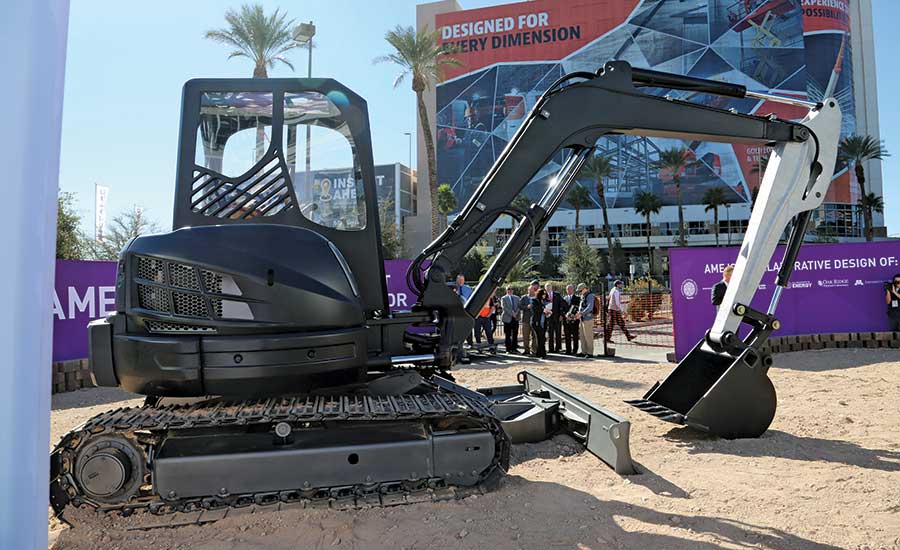A star of the CONEXPO/CON-AGG show in Las Vegas in early March was an unassuming, unbranded mini excavator busily moving dirt around in a corner of the show. It was the progeny of Project AME, a collaboration between a national laboratory and industry, academic and government partners to bring 3D printing to an industrial scale in service of construction.
The goal was to produce significant parts of the machine—based on a Case New Holland 5.5-ton mini excavator and data that was contributed by the manufacturer—using three distinct 3D printing technologies and then integrating them with conventional parts into a functional machine in time for CONEXPO. Project leader Lonnie J. Love, a corporate research fellow from Oak Ridge National Laboratory in Oak Ridge, Tenn., says more parts could have been 3D-printed, but the team was rushing to meet the opening of the show.
Printed components included the cab, which was printed in five hours with carbon-fiber-reinforced ABS plastic on Cincinnati Inc.’s “big-area additive manufacturing” (BAAM) printer; the 7-ft-long, 400-lb “stick” at the end of the boom, which was printed in five days on a Wolf Robotics “Wolf Pack” printer, using a new arc-fused steel-wire process, co-developed with the lab; and a 13-lb aluminum heat exchanger, printed in about 10 days by laser sintering on a Concept Laser X-line 1000 powder bed machine.
“It’s not going to replace traditional manufacturing,” Love says, “but it has a lot of potential in low-volume, one-of-a-kind production because you don’t have tooling.” He says that on-demand production could help to eliminate the need for manufacturers to maintain parts inventories for equipment that can have a service life of 50 years. Further, it could be used to create tooling for conventional manufacturing processes. “The creation of those tools is the killer application of additive printing,” Love says.
Love says carmakers often spend $200 million a year per car model for tooling. “It’s one of a kind, and every mold is different. And they’re big, too, usually made out of a solid piece of steel.”
The tooling for the hood of a car, for example, might start as a 4-ft-long by 4-ft-wide by 3-ft-thick piece of forged steel and take months to be delivered—and then require a lot of machining to get the right form. “The lead time is usually months—up to years,” Love says. “With additive printing, you start with a wire and you can make it hollow on the inside or honeycombed. You can print a good-sized mold in days for tens of thousands of dollars, instead of years and millions.”
Love says the team included the National Fluid Power Association’s Eric Lanke, who proposed the project; Mike Gust, the University of Minnesota’s Center for Compact and Efficient Fluid Power industry liaison who coordinated production of the student-designed cab with Rick Neff, a BAAM sales manager at Cincinnati Inc. Also on the team were Mark Schaub, representing Wolf Robotics, and John Rozum, an Association of Equipment Manufacturers director who coordinated with CONEXPO.
As the donor of the mini excavator, Gary Kassen, engineering director at Case New Holland, says, “I saw this could dramatically shorten our development time on new products and that low-volume specialty options could be viable. The project delivered on both.”
In remarks at the unveiling, Love said the project exemplifies the service national labs can provide through cooperative research and development agreements that safeguard intellectual property and share development costs while opening up process improvements to industry. “The message of Project AME is not about just 3D-printing an excavator. It’s about using something like CONEXPO as a forcing function to get scientists and engineers to work side by side with industry to make it more competitive.”





Post a comment to this article
Report Abusive Comment